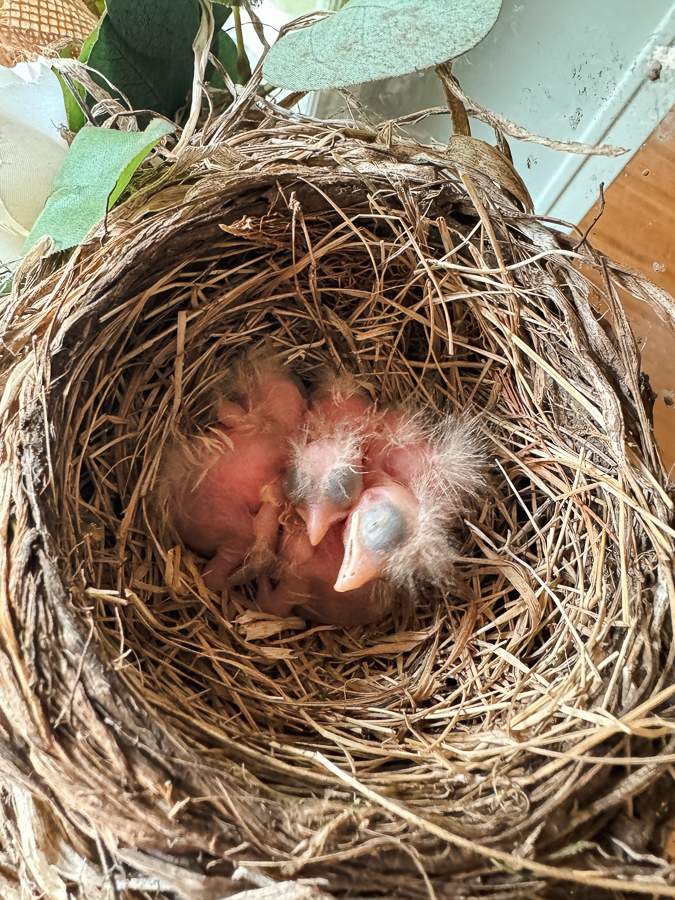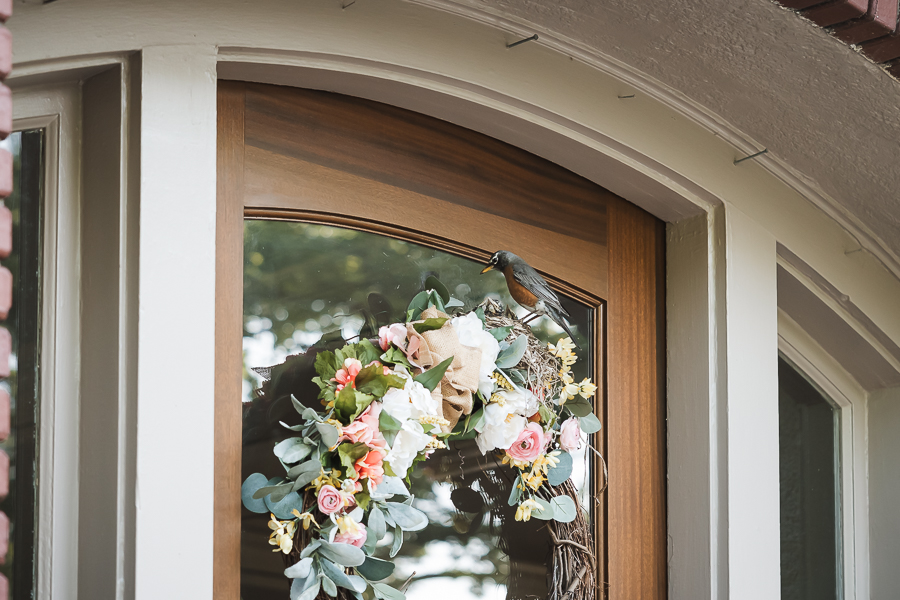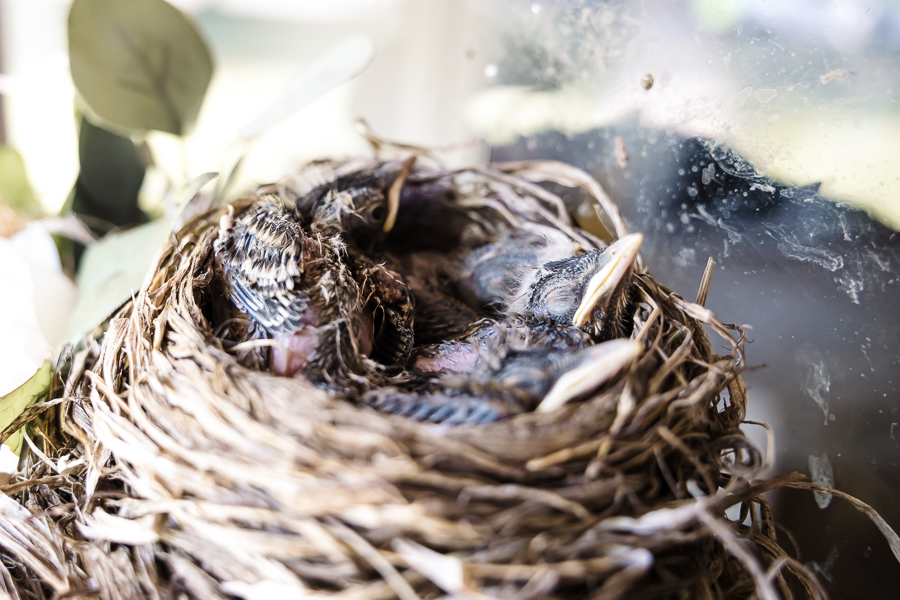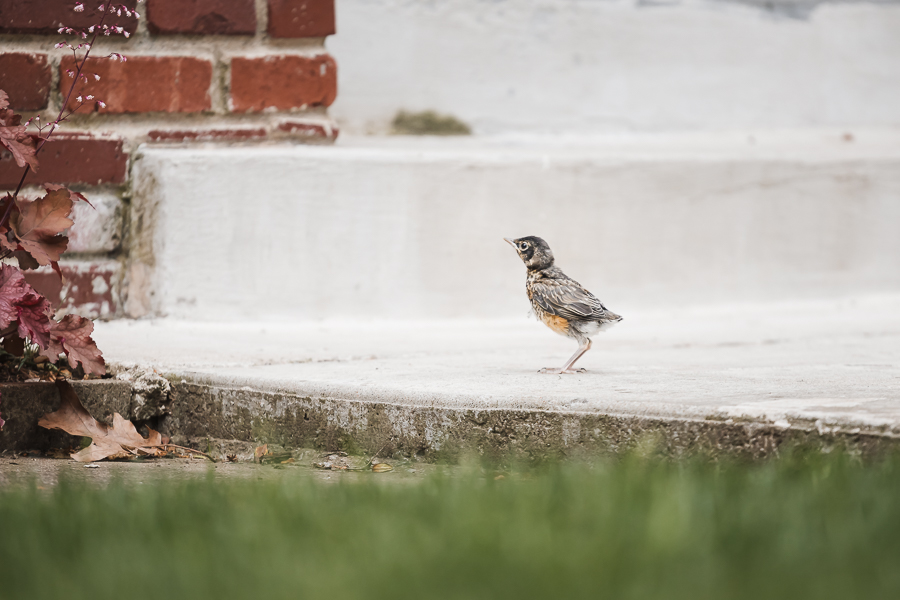“Well…I guess we won’t be using the front door for the next month.”

That’s what I said to Tripp on March 26th after I discovered that a robin had built her nest in the wreath on our front door. And upon further investigation, I found two tiny eggs in it – robin’s egg blue, naturally.

I’ve had the opportunity to witness this amazing process many times over the years that we have lived in this house, and so I decided to share daily (ish) updates with my friends on Instagram. I placed a dining room chair near my front door and took a photo or video with my phone in the afternoon. I love that my friends enjoyed following along on this journey, and so I thought I would share it here on my blog too.
The first stage of the process is the building of the nest which I missed because I was out of town on a work trip. But the momma would have started by pressing dead grass, moss, or other small twigs into the cup shape with the wrist of one of her wings. (Who knew robins had wrists???) Then, once she had the cup formed, she would have reinforced the nest with soft mud to make it heavy and sturdy. As a final step, she lined it with fine dry grass to make a cozy home for her babies.
It is a work of art if you ask me.
There were two eggs on the day I discovered the nest. The next day produced another tiny egg and then another one the day after for a total of four – a full clutch.


The next stage in the process is incubation, and typically a female will wait until after she has laid all her eggs so that they will all hatch at about the same time. And that’s where she spent the majority of her days for the next couple of weeks. I would always say “Hi Momma!” whenever I walked by the front door.

While the female is incubating her babies, the male robin is always close by, keeping watch when she is away from the nest for feeding or in case she calls out in distress.

A female robin keeps eggs warm (even on chilly nights) with her “brood patch”, a hidden spot on the under side of her belly where her feathers have fallen out. This way she can press her bare warm belly directly on the eggs to keep them warm. Her brood patch also allows her to “take the temperature” of her eggs (so to speak), and she can adjust her position in the nest or leave the nest to allow the eggs to cool a bit, depending on what they need. A couple times I saw where she was standing on the edge of her nest turning and rotating her eggs – this helps to keep them evenly warm and to prevent the babies from sticking to the inside of the shell.



Incubation typically lasts anywhere between 12 to14 days from when the last egg was laid, and for this momma’s brood, two hatched on April 8th, one on the 9th, and the last one on the 10th.



That’s when the real work of keeping the hungry babies fed begins. Back and forth, dozens of times a day, both the male and female share the responsibility of bringing food to the nest.

I would always wait until the parents were away before opening the front door to take a quick photo of the babies. Being able to see the nest up close, it was amazing to watch them literally growing before my eyes. They start out almost completely naked, and then by the fifth day they start developing feathers.




My office is directly up the stairs from the front door, and as they got bigger, I could hear the babies, chirping and hollering whenever one of their parents came back with food.






It’s amazing how fast the nestlings grow in such a short time. This was taken just a week after they hatched.

After another week and the babies had developed feathers and you could see their colors starting show. And by April 22nd, the nest was getting really crowded.

The next morning, one of the nestlings had gotten brave and stepped out of the nest onto the wreath.

When I checked on it a little later, it was gone. I saw the male hopping and chirping around in my neighbor’s front yard so I figured he was watching over this brave little fledging. Sure enough, I found it perched on a nearby shrub.

When I came downstairs early the next morning, two of the remaining babies had already left the nest, so it was down to one.

And by that afternoon, this last baby had left the nest. But I could hear it’s sweet little peeping sound near the front porch so I walked around with my camera to see if I could get a better look at this cutie.



Not pictured: Mom and Dad hopping around nearby letting me know that they were keeping a close eye on me.
Once the babies leave the nest, they spend the next couple of weeks nearby (under the watchful eye of the male) learning to hunt for food and developing their wings. I can still hear their little chirping voices calling out for food and I’ll catch a peek of them in the lower tree branches from time to time. In a couple of weeks they’ll be strong fliers and will go off on their own.
Lest you think the momma robin will have an epic empty-nest meltdown and take up photography or start a blog <<wink>>, she has probably already scouted the location and started building her next nest for her next brood.

After the last robin left the nest, I took down the wreath and cleaned my front door. And like I have done many times in past years, I carefully removed the nest from my wreath to add to my little collection of bird nests that serve as a reminder of my own empty-nest journey.
I’m so grateful to have had a front row seat to this amazing process. It has been a blessing to watch these past few weeks, and I hope sharing it gives you the same feelings of wonder and joy.
Love, Kelly

This is incredible and amazing! Thanks for documenting and sharing as you do so beautifully. It goes by so fast! So the idea is she will have another brood this season?
Mari I’m so glad to know you enjoyed following along! And yes, robins usually have 2-3 broods per season.